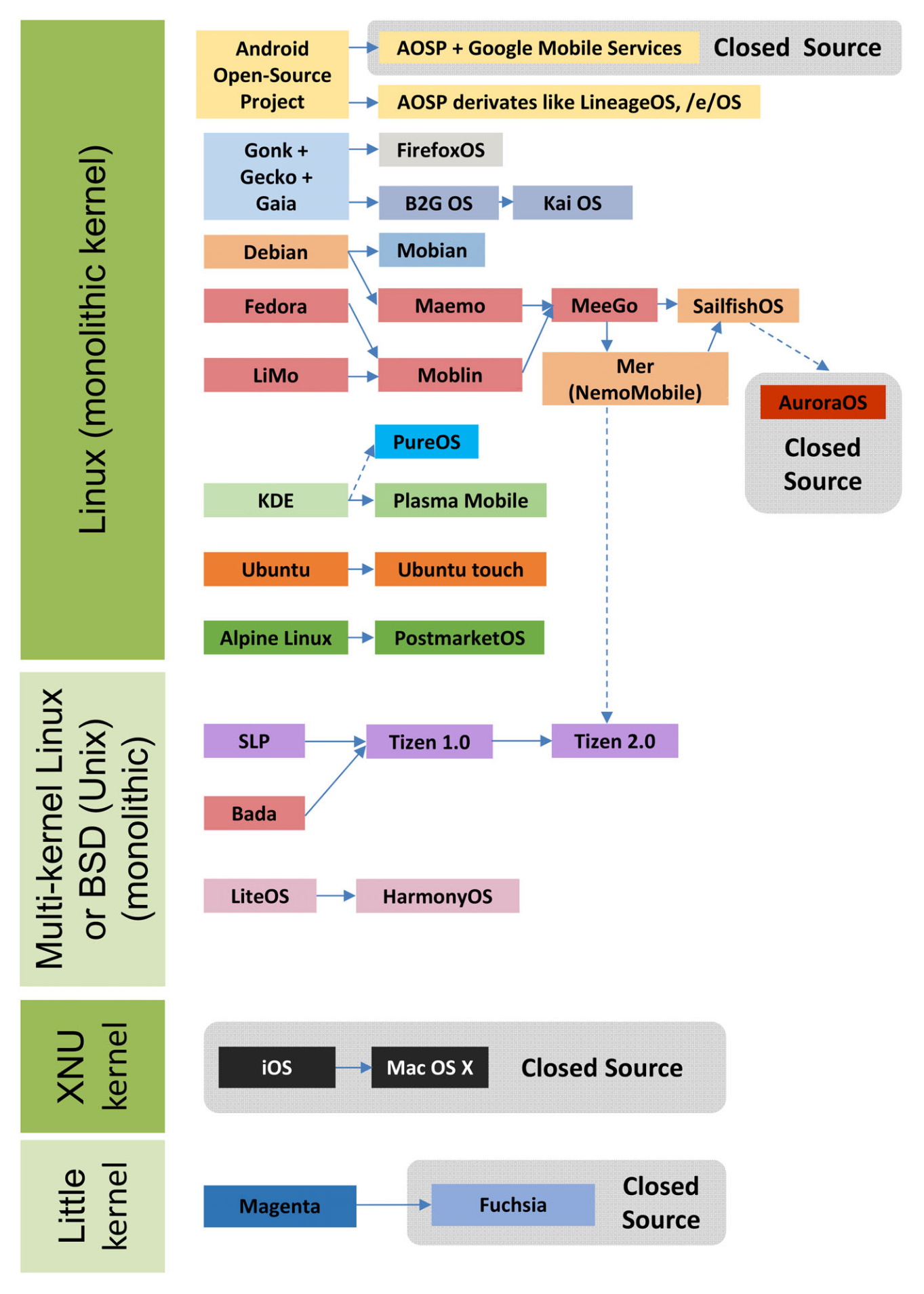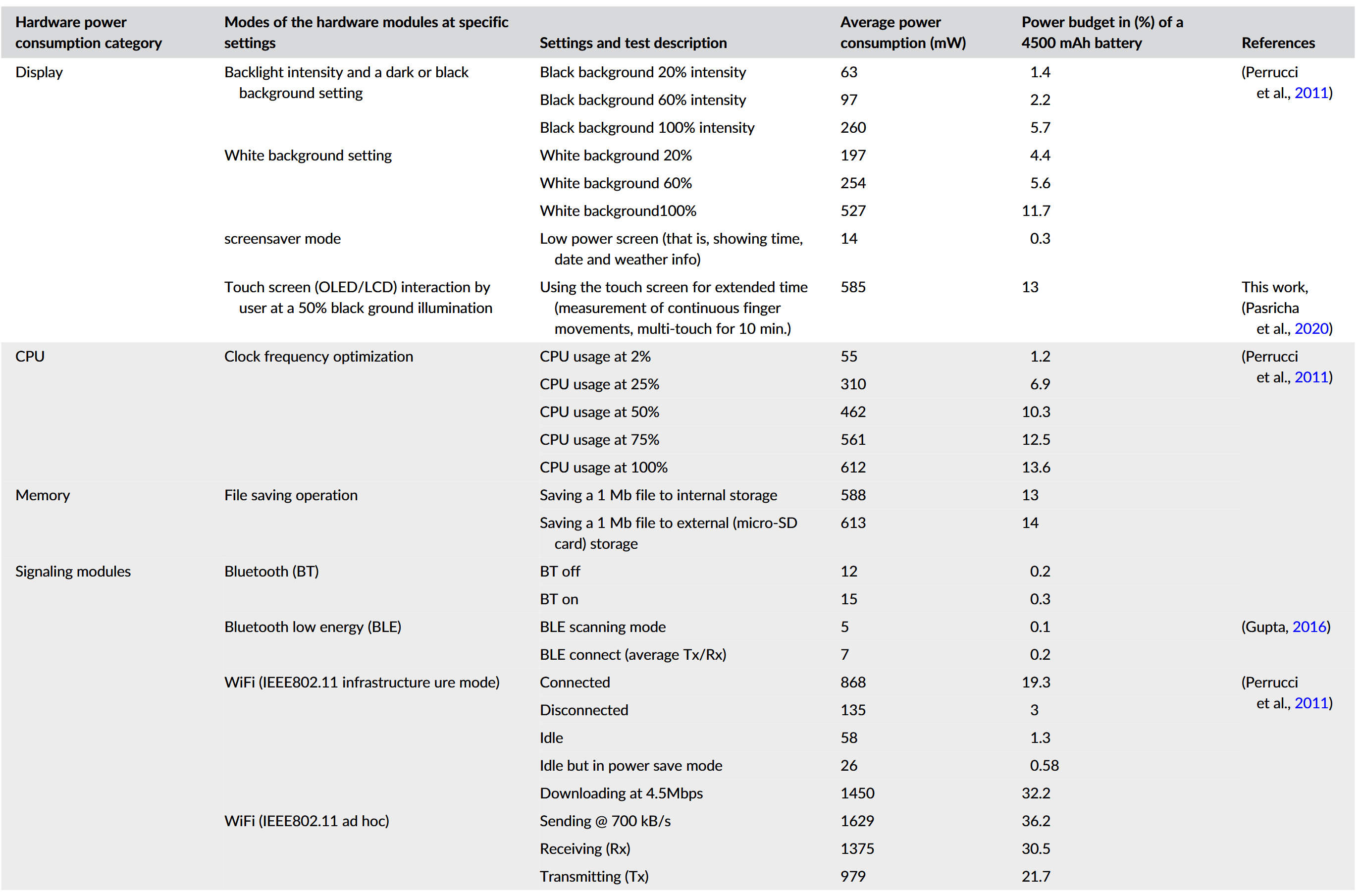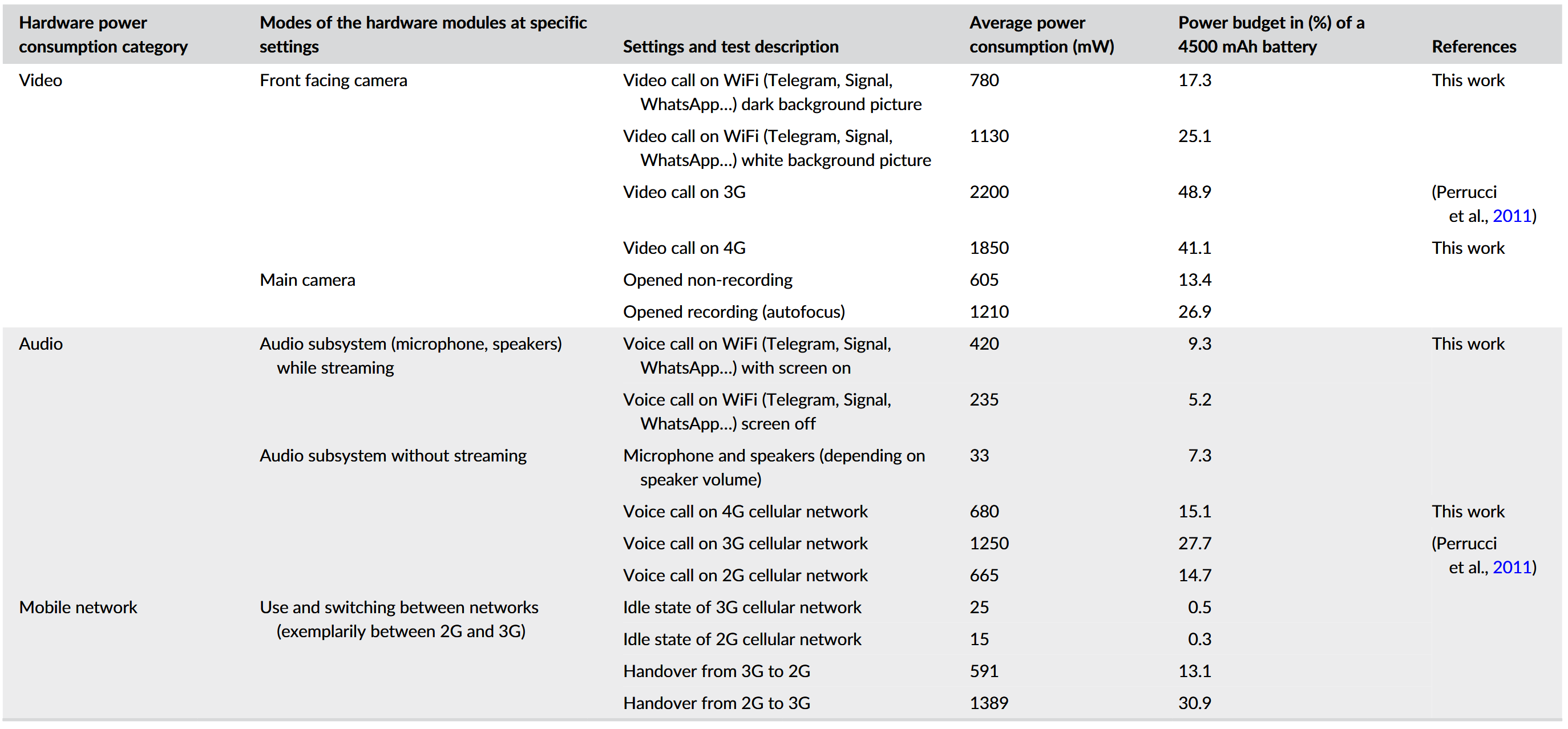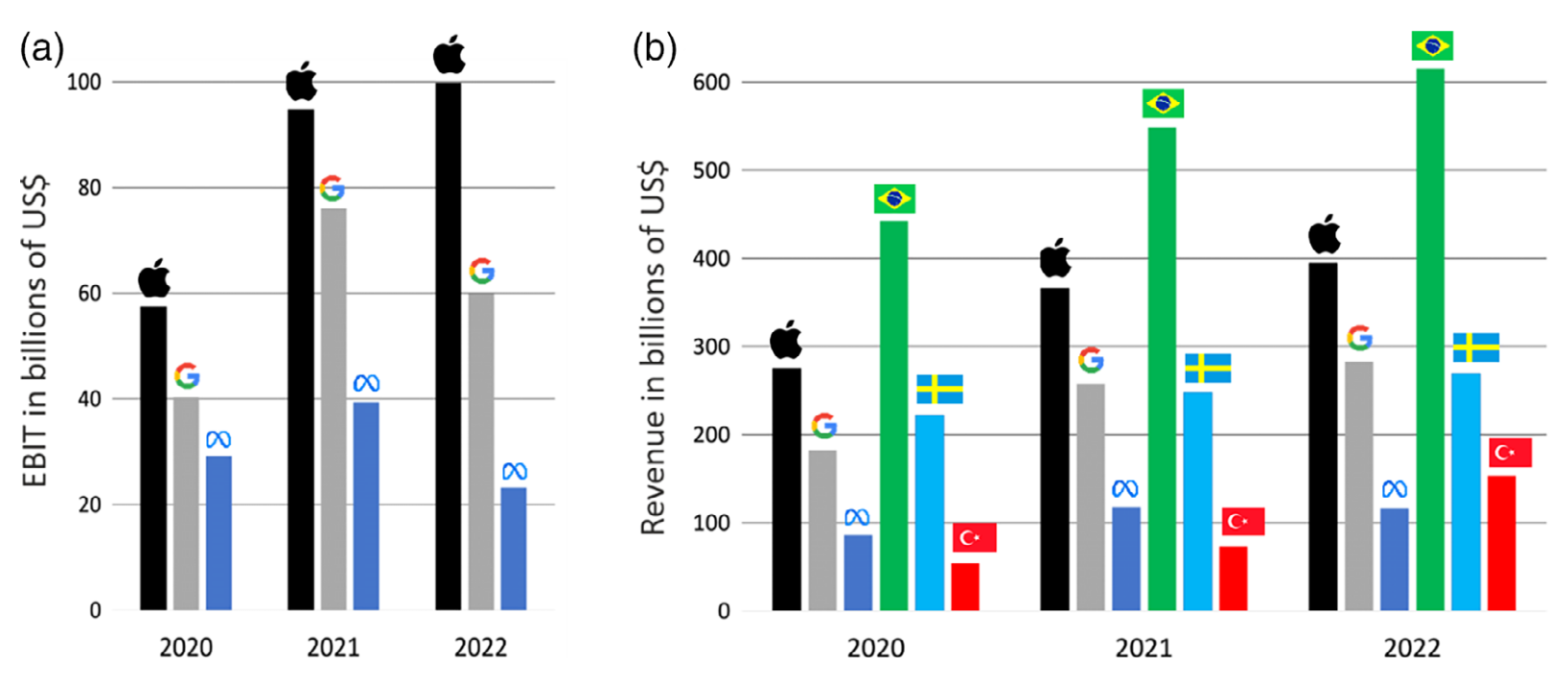Sustainable use of a smartphone and regulatory needs
Status:: 🟩
Links:: Carbon footprint of smartphones Fediverse LineageOS
Metadata
Authors:: Kögler, Martin; Paulick, Katharina; Scheffran, Jürgen; Birkholz, Mario
Title:: Sustainable use of a smartphone and regulatory needs
Publication Title:: "Sustainable Development"
Date:: 2024
URL:: https://onlinelibrary.wiley.com/doi/abs/10.1002/sd.2995
DOI:: 10.1002/sd.2995
Kögler, M. et al. (2024) ‘Sustainable use of a smartphone and regulatory needs’, Sustainable Development, n/a(n/a). Available at: https://doi.org/10.1002/sd.2995.
The significance of information and communication technologies (ICT) for the Paris Climate Agreement is continuously increasing because of its growing energy consumption. Here we examine the question for the smartphone and extend the investigation to more aspects of sustainability. Critical issues are identified for ten UN Sustainable Development Goals. Measurements of smartphone energy consumption show that a significant savings potential can be unlocked by reducing the data outflow and the large amount of personal data stored in data centers. Main discrepancies are also traced to the oligopolistic market structure of operating systems (OSs), messenger services, and social media apps. Technical means for a sustainable smartphone use are suggested as alternative OSs, social media channels of the Fediverse, as well as free and open-source software. Finally, societal conditions are emphasized to make the market for OSs and apps more diverse so that a sustainable smartphone use can generally prevail.
Notes & Annotations
Color-coded highlighting system used for annotations
📑 Annotations (imported on 2024-09-14#20:19:51)
Overall, the internet now claims 10% of global electricity production and is projected to increase to 20% in 2030 (Andrae & Edler, 2015).
Projection by Andrae & Edler, 2015 used wrong assumptions. It was corrected by Andrae in 2020. In general it is not possible to make a projection of the energy consumption trend of the internet for such a long period of time.
Based on our own measurements (see Supporting information Data S1 and S2), we estimate the average energy consumption of a smartphone to lie between 1 and 5 kWh/a, with large variations depending on model, mobile OS, and user habits. This results in a total energy demand for the level of local smartphone operation on the order of about 7 TWh/a.
Other sources assume an emission of 47 kg CO2 during the entire service life of a single smartphone, with the main share being attributable to production (Bieser et al., 2022).
Bieser, J. C. T., Blumer, Y., Burkhalter, L., Itten, R., Jobin, M., & Hilty, L. M. (2022). Consumer-oriented interventions to extend smartphones' service lifetime. Cleaner and Responsible Consumption, 7, 100074.
Nevertheless, it has been shown that consumption at both tiers of data centers and network traffic is largely determined by user behavior and settings of the smartphone OS, that is, on tier three of end user devices (Papadopoulos et al., 2019; Uijttewaal et al., 2021).
Papadopoulos, P., Kourtellis, N., & Markatos, E. (2019). Cookie synchronization: Everything you always wanted to know but were afraid to ask. The world wide web conference, 1432–1442, San Francisco CA USA: ACM.
@Uijttewaal.etal.2021.CarbonFootprintUnwanted
Today, the paradox is generally captured under the term of rebound effects (Ruzzenenti et al., 2019).
Ruzzenenti, F., Font Vivanco, D., Galvin, R., Sorrell, S., Wagner, A., & Walnum, H. J. (2019). Editorial: The rebound effect and the Jevons' paradox: Beyond the conventional wisdom. Frontiers in Energy Research, 7, 90.
In addition, we seem to observe the Jevons effect to act in the ICT sector in an exemplary way, since all the gains in effectiveness in computing power have never led to a decline in power consumption in the recent years (Mills, 2019).
Mills, M. P. (2019). The “new energy economy”: An exercise in magical thinking. The Manhattan Institute: New York, NY, USA.
Implemented into Google's Android and Apple's iOS are system trackers, which the user has to accept in order to use the phone via agreeing to the End User License Agreement at the first booting up (Agrawal et al., 2022).
Agrawal, D., Zhang, C., Kettinger, W. J., & Adeli, A. M. (2022). Spy it before you try it: Intrinsic cues and open data app adoption. Communications of the Association for Information Systems, 50, 554–575.
Google's AndroidTM, which dominates the global market, on the other hand, includes as an essential component a group of proprietary software modules collectively known as Google Mobile Services (GMS). They encompass application programmable interfaces (API) and key programs such as PlayStore to gain access to more GMS apps, Google Maps, and YouTube, among many others. By integrating more programs into GMS, Alphabet/Google has transformed Android into an increasingly closed OS in recent years, originally designed according to FOSS principles (Amadeo, 2018).
Amadeo, R. (2018). Google's iron grip on android: Controlling open source by any means necessary [Arstechnica technical review]. Access from Google's Iron Grip on Android: Controlling Open Source by any Means Necessary from the Archives: Android Is Open—Except for all the Good Parts. Website https://arstechnica.com/gadgets/2018/07/ googles-iron-grip-on-android-controlling-open-source-by-any-meansnecessary/

Evolution of smartphone operation systems; based on and further developed from Grolleau, (2021).
Personal note: Not sure why Fuchsia is marked as "closed source". It is an open source OS (https://fuchsia.dev/fuchsia-src/development).
Moreover, new tracking methods are constantly being developed (Meineck, 2023), with one well-established example is being browser fingerprinting, which enables user identification based on technical parameters, such as screen size, browser type, version number, and so on. (may be checked on www.amiunique.org). Another approach relies on Facebook's engagement buttons allowing the company to monitor about 52% of all websites visited (Aguiar et al., 2022).
Aguiar, L., Peukert, C., Schaefer, M., & Ullrich, H. (2022). Facebook Shadow Profiles (February 2022). DIW Berlin Discussion Paper No. 1998. https://doi.org/10.2139/ssrn.4032514
Spying on virtually all smartphone users and broad-based user profiling is not in line with SDG#12 to ensure sustainable consumption and production patterns. Indeed, SDG#12 aims to reduce resource consumption, whereas ever more technically optimized advertising causes overconsumption of natural resources. Moreover, the progressing accumulation of sensitive personal data at private companies does not comply with SDG#16 to “build accountable and inclusive institutions at all levels.” Rather, the large tracking companies generally evade their duty of disclosure and accountability to users.
Because of the wide variation in circulating devices and in user behavior, there are only a few studies on the breakdown of energy consumption of individual smartphone processes like (Gupta, 2016; Pasricha et al., 2020; Perrucci et al., 2011) and some of their results have been collected in Table 1. In addition, we performed further measurements on a Sony Xperia 10 III with a 4500 mAh battery, on which the Stock-Android (GMS) was replaced with the current version of SailfishOS, including an activated android (AOSP) subsystem (additional Sailfish X license). This device can be considered as a typical, but tracker-free smartphone due to its state-of-the-art performance. The open-source app SystemDataScope (rinigus, 2022) was applied for the measurements and the data obtained have also been included in Table 1.
Gupta, N. (2016). Inside Bluetooth low energy (2nd ed.). Artech House.
Pasricha, S., Ayoub, R., Kishinevsky, M., Mandal, S. K., & Ogras, U. Y. (2020). A survey on energy Management for Mobile and IoT devices. IEEE Design & Test, 37, 7–24.
Perrucci, G. P., Fitzek, F. H. P., & Widmer, J. (2011). Survey on energy consumption entities on the smartphone platform. In 2011 IEEE 73rd vehicular technology conference (VTC Spring) (pp. 1–6). IEEE.
It is evident from the table that not only screen usage, especially with white background, but also communication in mobile and WLAN networks consumes significant portions of energy. In addition, video calling severely contributes to a rapid temperature increase and discharge of the battery.
From various measurements and literature sources we estimate, however, that a single smartphone requires between 1 and 5 kWh of electrical energy per year. With a total number of 6.6 billion subscriptions active, this results in an amount of about 7–33 GWh/a of electrical energy that was consumed by smartphones in 2022.
The carbon footprint and energy consumption of data centers and mobile networks associated with smartphone usage in Europe has recently been estimated by CE Delft (Uijttewaal et al., 2021). The main focus of the study was on advertising and tracking services (ATS), to which the 546 million European cellular subscriptions in 2020 were subjected (World Bank, 2023).
@Uijttewaal.etal.2021.CarbonFootprintUnwanted
This results in an energy consumption of 19 and 32 TWh/a for advertising and tracking activities on smartphones in Europe, if ATS shares of 10% and 17% are assumed, as determined before (VallinaRodriguez et al., 2016). These values are on the order of 10%–20% of the energy generated in 2020 by photovoltaics in Europe, amounting to 170 TWh (Hanna Ritchie et al., 2022), and appears an enormous waste of energy, since about 60% of users reject the playout of ATS on their smartphones (Uijttewaal et al., 2021).
Vallina-Rodriguez, N., Sundaresan, S., Razaghpanah, A., Nithyanand, R., Allman, M., Kreibich, C., & Gill, P. (2016). Tracking the trackers: Towards understanding the Mobile advertising and tracking ecosystem. arXiv.

Table 1 Energy profile and average power consumption of various hardware components during operation in a smartphone from own measurements (exemplarily a Sony Xperia 10 III with a 4500 mAh battery was used) and from literature sources.

Table 1 (Continued)
As Williams et al., (2022) point out, studies on mobile data traffic usually fail to consider aspects such as overall operational energy, the impact of embodied energy and changes in user behavior. For embodied energy in particular (Humar et al., 2011), they note that the new installation of network infrastructure with energy costs for the manufacture of devices and the disposal of old devices is hardly considered and systematically underestimated.
A Significant Amount Of Renewable Energy Is Directed To Advertising And Tracking Application That Would Have Been More Wisely Used To Strive For Climate Action In Terms Of Sdg#13.
The Methods Of Video Platforms Do Not Live Up To Sdg #12, Which Calls For “sustainable Consumption And Production.” In Particular, For Tiktok Analysts Note That The Endless Looping Of Videos Implements An Algorithm That Tries To Get People Addicted Rather Than Giving Them What They Really Want (bain, 2023). As Of March 2023, It Is Reported That The Hashtag #tiktokmademebuyit Has Been Accessed More Than 40 Billion Times, In Many Cases By Disappointed Users Who Did Not Need The Purchased Product At All.

Figure 5 (a) Earning before interests and taxes and (b) revenues in billions US $ of the three major internet companies in the smartphone sector, Alphabet/Google, Apple, Meta/Facebook, and exemplarily a comparison of revenues to countries like Brazil, Sweden, and Turkey.
In Withdrawing Financial Resources From Billions Of Smartphone Users To A Few Companies, There Is A Clear Discrepancy With Sdg #10, Which Calls For Less Inequality Within And Between Countries. As A Consequence, There Results Another Incompatibility With The Un Sdgs, Namely Sdg #1, Which Addresses The Fight Against Poverty. In Fact, The Profits Accumulated By A Few Companies Are No Longer Available To The Great Mass Of Users And Are Lacking In The Fight Against Poverty And Homelessness Or For Financing School Buildings And Qualified Teachers In Many Countries, To Mention Only A Few Pressing Issues.
A crucial step toward improving the sustainability balance is to use the smartphone for as long as possible. Consumers should try to keep their system continuously updated to prolong its lifespan in order to contribute to activities in reducing electronic waste (Borland et al., 2019; Testa et al., 2024).
A system-wide solution to prevent unwanted tracking is to use the internet's domain name system (DNS). The process of translating a URL into an IP address can be exploited by using dedicated DNS servers that maintain lists of compromising sites. For each request of a web page, the DNS server may block a translation for undesired pages and thus tracking cannot be played out. Although this method is subject to permanent contest, it has proven to be comparatively effective (Kuketz, 2021).
On The Part Of Policymakers, Measures Must Be Taken To Extend The Service Life Of Smartphones. These Can Be Achieved, For Example, Through Standardization As Has Already Been Demonstrated In The Case Of Charging Connectors In The Eu. For The Standardization Based On The Usb-c Plug, Which Will Become Mandatory From 2024 On, A Reduction In Electronic Waste Of Nearly 1000 T Can Be Expected (ec, 2022), Whereas Environmental Groups See Much Larger Potentials (ecos, 2020). Similar Specifications Should Be Made For Smartphone Batteries To Enable Easier Replacement And Self-repair By The User. In Addition, Specifications Should Be Made For The Long-term Stability Of Electrical Parameters, Which Would Reduce The Volume Of Battery Waste In Accordance With Sdg#12.
Research Funding Programs For The Advancement Of Foss, Custom Roms, And The Fediverse Should Be Set Up And Developed. In Part, Such Funding Programs Are Already Available, But The Funding Volumes Should Be Adapted To The Budgets Available To Proprietary Software. This Would Be Inline With Foss Intention To Promote Social Cohesion In Agreement With Sdg#16 And #17.
Meanwhile, The Energy Consumption Of Smartphones And The Network Infrastructure Pose A Severe Threat To Sdg#7. This Energy Consumption, And Especially Its Ongoing Increase, Is Counterproductive To Sdg#13, And “... The International Community Is Falling Far Short Of The Paris Goals, With No Credible Pathway To 1.5 C In Place” (unep, 2022).